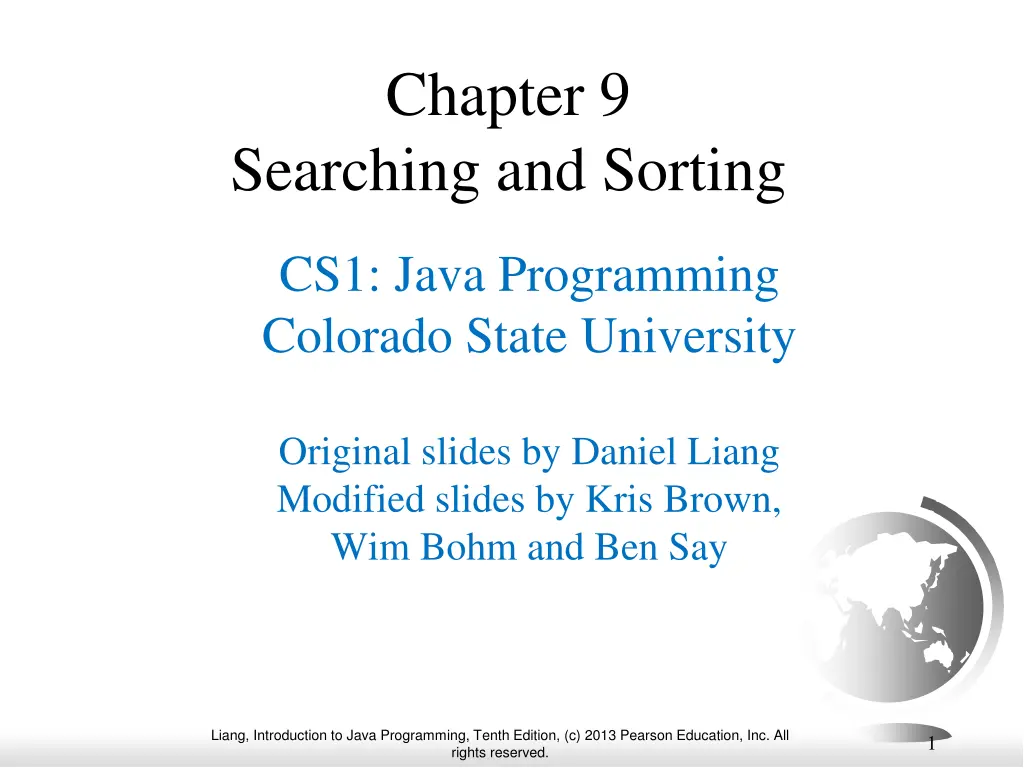
Searching and Sorting in Java Programming at Colorado State University
Explore the concepts of linear search and binary search in Java programming. Learn about the process of searching for specific elements in arrays and the importance of sorting data structures. Enhance your skills with helpful animations and practical examples from the Introduction to Java Programming book.
Download Presentation

Please find below an Image/Link to download the presentation.
The content on the website is provided AS IS for your information and personal use only. It may not be sold, licensed, or shared on other websites without obtaining consent from the author. If you encounter any issues during the download, it is possible that the publisher has removed the file from their server.
You are allowed to download the files provided on this website for personal or commercial use, subject to the condition that they are used lawfully. All files are the property of their respective owners.
The content on the website is provided AS IS for your information and personal use only. It may not be sold, licensed, or shared on other websites without obtaining consent from the author.
E N D
Presentation Transcript
Chapter 9 Searching and Sorting CS1: Java Programming Colorado State University Original slides by Daniel Liang Modified slides by Kris Brown, Wim Bohm and Ben Say Liang, Introduction to Java Programming, Tenth Edition, (c) 2013 Pearson Education, Inc. All rights reserved. 1
Searching Arrays Searching is the process of looking for a specific element in a container data structure. There are many algorithms and data structures devoted to searching. In this section, two commonly used approaches are discussed, linear search and binary search. Liang, Introduction to Java Programming, Tenth Edition, (c) 2013 Pearson Education, Inc. All rights reserved. 2
Linear Search The linear search approach compares the key element, key, sequentially with each element in the array list. It continues to do so until the key matches an element in the list or the list is exhausted without a match being found. If a match is made, it returns the index of the element in the array that matches the key. If no match is found, the search returns -1. Liang, Introduction to Java Programming, Tenth Edition, (c) 2013 Pearson Education, Inc. All rights reserved. 3
animation Linear Search Animation Key List 6 4 1 9 7 3 2 8 3 6 4 1 9 7 3 2 8 3 6 4 1 9 7 3 2 8 3 6 4 1 9 7 3 2 8 3 6 4 1 9 7 3 2 8 3 6 4 1 9 7 3 2 8 3 Liang, Introduction to Java Programming, Tenth Edition, (c) 2013 Pearson Education, Inc. All rights reserved. 4
Binary Search For binary search to work, the elements in the array must be sorted. Binary search first compares the key with the element in the middle of the array (think of searching a word in a dictionary) Liang, Introduction to Java Programming, Tenth Edition, (c) 2013 Pearson Education, Inc. All rights reserved. 5
Binary Search, cont. If the key is equal to the middle element, the search ends with a match. If the key is less than the middle element, search in the first half of the array. If the key is greater than the middle element, search in the second half of the array. Liang, Introduction to Java Programming, Tenth Edition, (c) 2013 Pearson Education, Inc. All rights reserved. 6
animation Binary Search Key List 1 2 3 4 6 7 8 9 8 1 2 3 4 6 7 8 9 8 1 2 3 4 6 7 8 9 8 Liang, Introduction to Java Programming, Tenth Edition, (c) 2013 Pearson Education, Inc. All rights reserved. 7
Sorting Arrays Sorting, like searching, is also a common task in computer programming. Many different algorithms have been developed for sorting. We have already seen insertion sort and bubble sort. Liang, Introduction to Java Programming, Tenth Edition, (c) 2013 Pearson Education, Inc. All rights reserved. 8
Bubble Sort In each pass, Bubble Sort puts one element in its right place BubbleSort Run Run BubbleSort Liang, Introduction to Java Programming, Tenth Edition, (c) 2013 Pearson Education, Inc. All rights reserved. 9
Selection Sort Find the minimal element in the array and put it in it s right location. Then selection sort the rest of the array. Liang, Introduction to Java Programming, Tenth Edition, (c) 2013 Pearson Education, Inc. All rights reserved. 10
Selection Sort for (int i = 0; i < listSize; i++) { select the smallest element in list[i..listSize-1]; swap the smallest with list[i], if necessary; // list[i] is in its correct position. // The next iteration apply on list[i..listSize-1] } Expand double currentMin = list[i]; int currentMinIndex = i; for (int j = i+1; j < list.length; j++) { if (currentMin > list[j]) { currentMin = list[j]; currentMinIndex = j; } } Liang, Introduction to Java Programming, Tenth Edition, (c) 2013 Pearson Education, Inc. All rights reserved. 11
Selection Sort for (int i = 0; i < listSize; i++) { select the smallest element in list[i..listSize-1]; swap the smallest with list[i], if necessary; // list[i] is in its correct position. // The next iteration apply on list[i..listSize-1] } Expand if (currentMinIndex != i) { list[currentMinIndex] = list[i]; list[i] = currentMin; } Liang, Introduction to Java Programming, Tenth Edition, (c) 2013 Pearson Education, Inc. All rights reserved. 12
